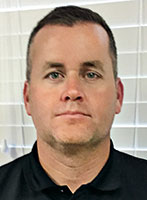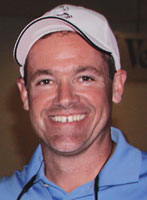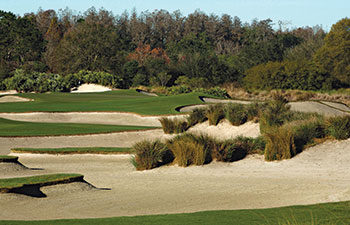Plant Health Part 1: A healthy plant wins the race
When Joe Kennedy, CGCS, compares a healthy turf plant to a marathon runner, he knows what he’s talking about. He’s been the superintendent at Vanderbilt Legends Club in Franklin, Tenn., for 24 years, and he’s run 13 marathons, including the New York City, Chicago and Boston Marathons.
“A marathon runner trains himself in more ways than just in the ability to run. You’re able to withstand different stresses that are placed on you during that, and I can use that analogy with grass,” Kennedy says. “If my grass is as healthy as I hope it can be than it’s going to withstand a lot more stress than people give turf credit for. We’ve had that success over the years, and I don’t attribute it to any one thing, but we’ve been able to withstand a lot hotter temperatures and a lot colder temperatures than you would have thought may be possible.”
In that way, Kennedy defines plant health as more than just disease-free.

Trent Inman
“It’s the overall health of the plant, and I mean disease resistance, stress resistance, rooting depth, number of roots, things like that,” he says. “Most of the time, if I do everything I should do, I would compare my turf to a marathon runner.”
At Old Memorial Golf Club in Tampa, Fla., where Trent Inman, CGCS, has been superintendent for 12 years, the philosophy is similar.
“Plant health to me is basically what I need to keep the plant alive and growing given the stresses that we apply,” Inman says. “Most of the things that it takes to produce a good product on the course, i.e., low mowing heights, verticutting, aerification, judicious watering, etc., produce stress on turfgrass. Therefore, anything that will help keep the turf alive and healthy without being too succulent to me is extremely important, as playability is an underlying factor in most every decision that we make at our club.”
John Thompson, a superintendent for 19 years, the last three at Sycamore Hills Golf Club in Fort Wayne, Ind., agrees. “I think plant health is a combination of drought resistance, water management, how the plant looks and how it reacts to all of the stresses we put it under.”

Shuttling nutrients

Brian Thompson
To that end, the researchers at BASF developed a line of fungicide products that provide, “disease control that also offers optimum plant-growing efficiency and stress resilience,” says Brian Thompson, BASF’s strategic account manager.
It may seem counterintuitive to think of a line of fungicides as plant health products, but the new BASF Intrinsic franchise of products actually does just that. The line of fungicides includes products labeled for disease control and plant health under the brand names of Honor, Lexicon, Insignia, Pageant, Empress and Pillar.
These products not only fight disease, but help to make plants healthier by reducing the plant’s nighttime respiration rates, according to Thompson. “If you can reduce the respiration rate at night then it consumes fewer carbohydrates. What the plant does is experiences a net increase in carbohydrates and shuttles those nutrients into the roots, making the roots stronger.”
Stronger roots and reduced energy loss leads to a healthier plant.
Tournament time
Kennedy has seen this work firsthand at his course (which is owned by Vanderbilt University and serves as the golf team’s home course), during his preparation to host the NCAA Women’s Golf Championships.
“I did rely on BASF products to help me through that entire week-to-10-day period when I really couldn’t be out there making the applications that I normally would. The turf was put under stress because they required the greens to be faster than they normally would (be),” Kennedy says. “Leading up to the tournament, we made applications with products we knew would last and hopefully make the grass disease free and healthy enough to withstand what you were going to put it through.”
What Kennedy put it through was tournament conditions for better than a week. The tournament didn’t get delayed or run long, but the members want to play the same course that the ladies experienced. “You’ve got several days after that everyone wants to play the course just the way it was,” he says. “Including the same hole locations.”
At Sycamore Hills, John Thompson had a similar experience last year hosting the Web.com finals.
“You put the greens under so much stress during tournaments,” he says. “You start double cutting a week before the tournament actually even starts.”
Thompson says he sprayed Xzemplar, a BASF fungicide that is a key component of Lexicon, two weeks before the tournament and then sprayed it a week in advance of the tournament. When an 11-inch rain completely flushed all the nutrients out of the greens, Thompson was relieved he had good plant health serving as a backup.
“If I hadn’t sprayed it, the greens would not have held up as well as they did. We were even thinking that maybe we needed to fertilize after that much rain flushing the green system the way it did,” he says. “(The greens) looked awesome. The agronomist and I are going, ‘This is unbelievable how great they look.’ And I attest that to the Xzemplar. I’m really glad I made that application, because I think that if I had used a product that didn’t have the plant health in it, I don’t think they would have.”
Sycamore Hills’ Thompson says the greens were pushed to their absolute limits. But they saw success because they were healthy enough to withstand the tournament stress that they were put under.
“We had green speeds close to 13 every day,” he says. “They maxed out, but the players loved it.”
Renovation recovery
 After the tournament, Thompson began a bunker renovation project, sodding bunker faces sprayed with Honor, and 15 acres of bluegrass sod for the roughs treated with Lexicon. “They just popped,” Thompson says.
After the tournament, Thompson began a bunker renovation project, sodding bunker faces sprayed with Honor, and 15 acres of bluegrass sod for the roughs treated with Lexicon. “They just popped,” Thompson says.
As he finishes the last few holes under renovation before this years’ tournament in September, he’s again included the BASF Intrinsic line in his arsenal of tools to achieve optimum plant health.
“I have an acre and a half of bentgrass sod that’s going on a fairway this spring and I actually sent some Lexicon to the sod grower,” Thompson says. “He’s going to spray it before we harvest it, for the roots.”
Thompson did this, he says, because of a Michigan State study that tested the turgidity of sod. The stronger the root mass, the harder it was to pull apart.
“I’ve seen it firsthand. It’s amazing that it works,” he says. “With the big renovations we’ve been going under at Sycamore, anything I can do in the time frame to get the turf healthier for the tournament — I will use every trick of the trade to try to get it there.”
Thompson says that although these products are fundamentally fungicides, it makes sense to, “harness the ancillary benefit of plant health to help a plant become more robust, more resilient in the face of stress. It’s more or less a holistic approach,” he says.
Job security
 A facility doesn’t need to be hosting a major tournament or undergoing a renovation for the course to benefit from plant health. Plant health can make the golf course look better every day, and also improve the golfer’s experience.
A facility doesn’t need to be hosting a major tournament or undergoing a renovation for the course to benefit from plant health. Plant health can make the golf course look better every day, and also improve the golfer’s experience.
“There’s fewer inputs so there’s less disruption to play in terms of watering, hand watering or other applications,” Kennedy says. “Less frequent applications mean we’re out there less working among the players. I like to say that things like that add to the enjoyment golfers get, but they don’t know why. It looks better, we’re out there less, they’re having more fun, but they really don’t even know. So, if you have a healthier plant, you do less to it and you don’t interrupt play.”
And a better playing golf course means a happier membership, which directly impacts a superintendent’s career prospects.
“Obviously, for any of us, if our turf is not healthy our job is at risk,” Kennedy says. “So anything we can do to help the plant be healthier — completely healthy, not just disease-free — is going to impact our job security.
“In general, plant health is the most important thing we do,” Kennedy continues. “Without that we cannot do all the other things that are required by our members. If it’s not healthy we can’t make it roll 12 for long, or mow tight if it’s not healthy. I just think it’s key.”
Photos: Natalie Inman; Jim Mandeville / Nicklaus Design








